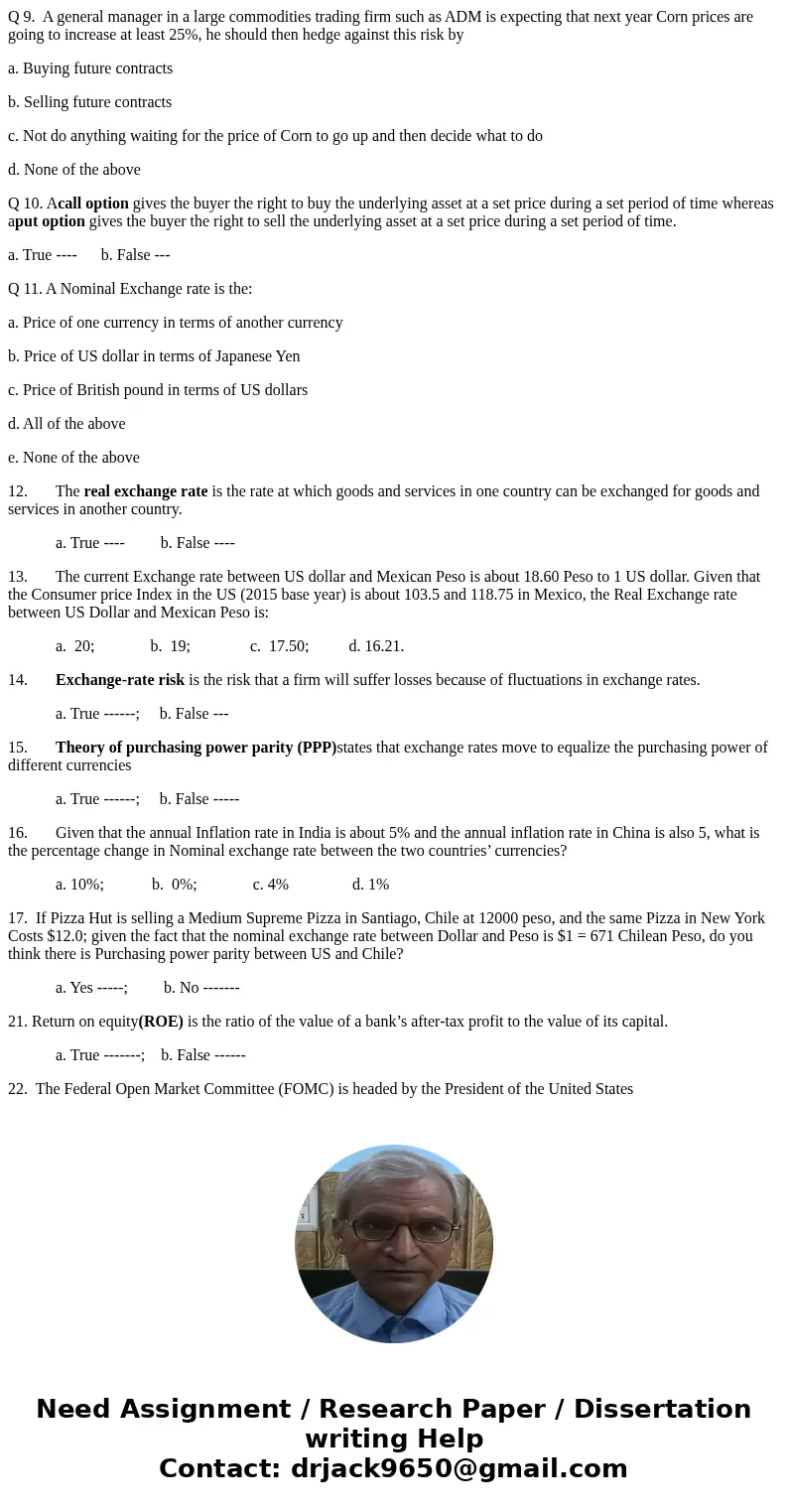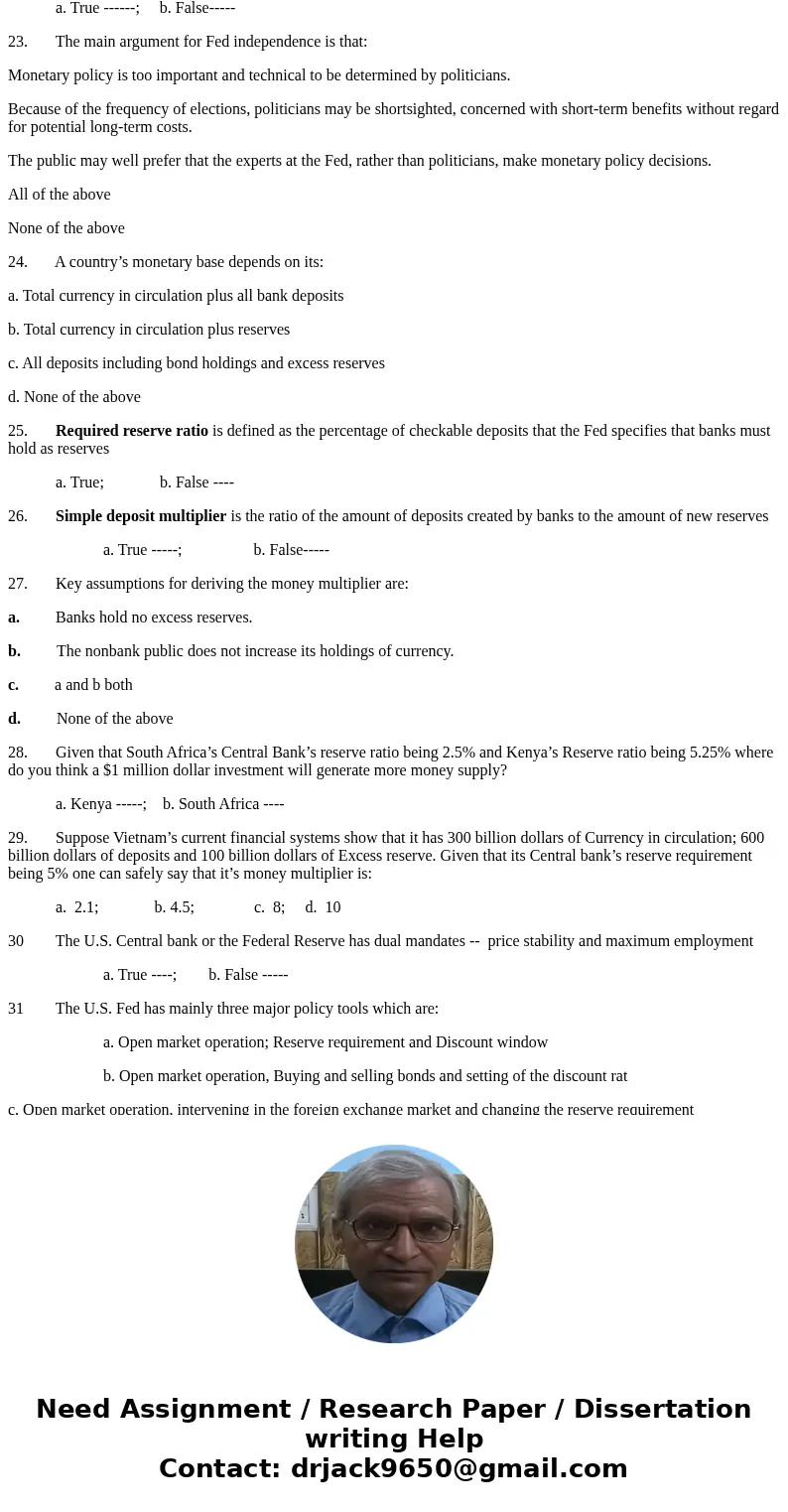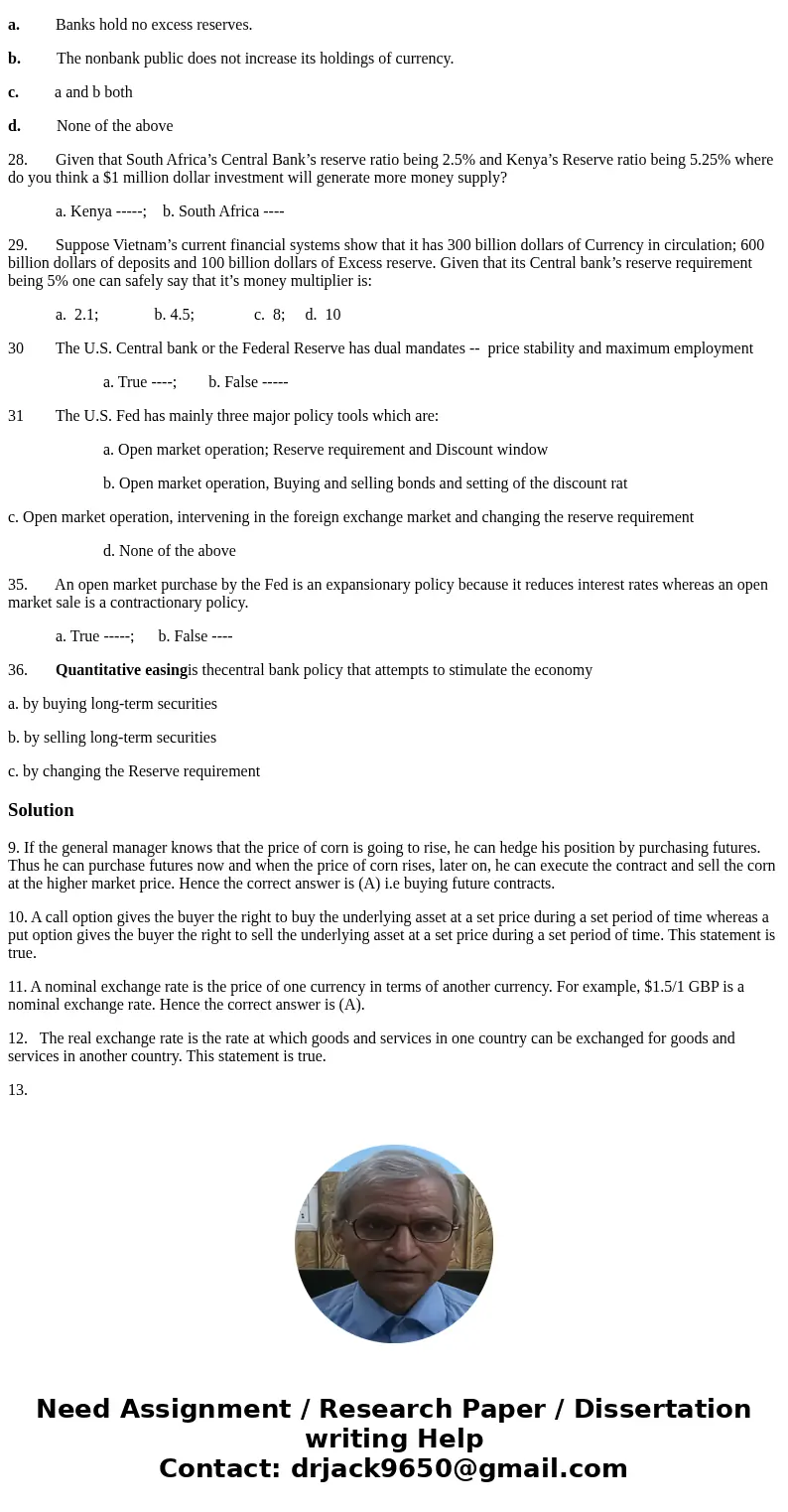Q 9 A general manager in a large commodities trading firm su
Q 9. A general manager in a large commodities trading firm such as ADM is expecting that next year Corn prices are going to increase at least 25%, he should then hedge against this risk by
a. Buying future contracts
b. Selling future contracts
c. Not do anything waiting for the price of Corn to go up and then decide what to do
d. None of the above
Q 10. Acall option gives the buyer the right to buy the underlying asset at a set price during a set period of time whereas aput option gives the buyer the right to sell the underlying asset at a set price during a set period of time.
a. True ---- b. False ---
Q 11. A Nominal Exchange rate is the:
a. Price of one currency in terms of another currency
b. Price of US dollar in terms of Japanese Yen
c. Price of British pound in terms of US dollars
d. All of the above
e. None of the above
12. The real exchange rate is the rate at which goods and services in one country can be exchanged for goods and services in another country.
a. True ---- b. False ----
13. The current Exchange rate between US dollar and Mexican Peso is about 18.60 Peso to 1 US dollar. Given that the Consumer price Index in the US (2015 base year) is about 103.5 and 118.75 in Mexico, the Real Exchange rate between US Dollar and Mexican Peso is:
a. 20; b. 19; c. 17.50; d. 16.21.
14. Exchange-rate risk is the risk that a firm will suffer losses because of fluctuations in exchange rates.
a. True ------; b. False ---
15. Theory of purchasing power parity (PPP)states that exchange rates move to equalize the purchasing power of different currencies
a. True ------; b. False -----
16. Given that the annual Inflation rate in India is about 5% and the annual inflation rate in China is also 5, what is the percentage change in Nominal exchange rate between the two countries’ currencies?
a. 10%; b. 0%; c. 4% d. 1%
17. If Pizza Hut is selling a Medium Supreme Pizza in Santiago, Chile at 12000 peso, and the same Pizza in New York Costs $12.0; given the fact that the nominal exchange rate between Dollar and Peso is $1 = 671 Chilean Peso, do you think there is Purchasing power parity between US and Chile?
a. Yes -----; b. No -------
21. Return on equity(ROE) is the ratio of the value of a bank’s after-tax profit to the value of its capital.
a. True -------; b. False ------
22. The Federal Open Market Committee (FOMC) is headed by the President of the United States
a. True ------; b. False-----
23. The main argument for Fed independence is that:
Monetary policy is too important and technical to be determined by politicians.
Because of the frequency of elections, politicians may be shortsighted, concerned with short-term benefits without regard for potential long-term costs.
The public may well prefer that the experts at the Fed, rather than politicians, make monetary policy decisions.
All of the above
None of the above
24. A country’s monetary base depends on its:
a. Total currency in circulation plus all bank deposits
b. Total currency in circulation plus reserves
c. All deposits including bond holdings and excess reserves
d. None of the above
25. Required reserve ratio is defined as the percentage of checkable deposits that the Fed specifies that banks must hold as reserves
a. True; b. False ----
26. Simple deposit multiplier is the ratio of the amount of deposits created by banks to the amount of new reserves
a. True -----; b. False-----
27. Key assumptions for deriving the money multiplier are:
a. Banks hold no excess reserves.
b. The nonbank public does not increase its holdings of currency.
c. a and b both
d. None of the above
28. Given that South Africa’s Central Bank’s reserve ratio being 2.5% and Kenya’s Reserve ratio being 5.25% where do you think a $1 million dollar investment will generate more money supply?
a. Kenya -----; b. South Africa ----
29. Suppose Vietnam’s current financial systems show that it has 300 billion dollars of Currency in circulation; 600 billion dollars of deposits and 100 billion dollars of Excess reserve. Given that its Central bank’s reserve requirement being 5% one can safely say that it’s money multiplier is:
a. 2.1; b. 4.5; c. 8; d. 10
30 The U.S. Central bank or the Federal Reserve has dual mandates -- price stability and maximum employment
a. True ----; b. False -----
31 The U.S. Fed has mainly three major policy tools which are:
a. Open market operation; Reserve requirement and Discount window
b. Open market operation, Buying and selling bonds and setting of the discount rat
c. Open market operation, intervening in the foreign exchange market and changing the reserve requirement
d. None of the above
35. An open market purchase by the Fed is an expansionary policy because it reduces interest rates whereas an open market sale is a contractionary policy.
a. True -----; b. False ----
36. Quantitative easingis thecentral bank policy that attempts to stimulate the economy
a. by buying long-term securities
b. by selling long-term securities
c. by changing the Reserve requirement
Solution
9. If the general manager knows that the price of corn is going to rise, he can hedge his position by purchasing futures. Thus he can purchase futures now and when the price of corn rises, later on, he can execute the contract and sell the corn at the higher market price. Hence the correct answer is (A) i.e buying future contracts.
10. A call option gives the buyer the right to buy the underlying asset at a set price during a set period of time whereas a put option gives the buyer the right to sell the underlying asset at a set price during a set period of time. This statement is true.
11. A nominal exchange rate is the price of one currency in terms of another currency. For example, $1.5/1 GBP is a nominal exchange rate. Hence the correct answer is (A).
12. The real exchange rate is the rate at which goods and services in one country can be exchanged for goods and services in another country. This statement is true.
13.



 Homework Sourse
Homework Sourse